Modern livestock production is increasingly using the incubation of quail eggs for mass marketing to the food market. In this article, we will consider the main issues about the incubation of quail chicks , which allows us to grow a healthy family of quails without major losses (financial and labor).
Quail eggs are in demand among buyers, as they contain many useful substances and are a low-calorie product. In addition, they have an attractive appearance and compact size and are inexpensive.
And it is the price of this product that is the driving force behind the decision to breed quails at home to replenish the budget. In addition, hatching quails in an incubator is quite an exciting activity, if there are children in the house.
First of all, we will analyze what incubation is and why it is needed and how to breed quails in an incubator.
Incubation is a certain period of time during which the process of development of the embryo in the egg takes place under conditions created artificially, but bordering on the natural environment.
Incubation for hatching birds is used using a special device ( incubator ), which is based on the temperature regime for keeping eggs and additional functions.
You can breed quails not only in production, but also at home, if space allows. This is a simple process, but a responsible one, since the health of future offspring depends on the quality of inspection and care of eggs.
What breeds of quail are suitable for incubation
There are eleven breeds of quails for breeding quails in an incubator:
In Russia, the "Manchurian" type of quail is bred. This category differs from others in that it actively lays eggs and is used in meat production. They are also popular in Europe;
- In China, these are "Chinese painted" quails. Unpretentious bird, adapts to any conditions (except frost). The disadvantages of this breed category include the small size of the bird itself;
- In the USA, these are "Texas", "California" and "Virgin" types of quail. The latter is bred for meat production and for park areas as an ornament, as the bird has a beautiful yellow-blue color of feathers. But the most popular American quail species is the Pharaoh, which has good egg laying characteristics;
- In the UK, these are "black" and "white" quails, which are laid on the 45th day of the count from birth, as well as the "Tuxedo" species, which has an unusual color of feathers;
- In Estonia it is "Estonian quail". It is distinguished by high productivity from other breeds of quail, because it begins to rush already on the 40th day after birth.
One quail can lay 1-2 eggs per day (depending on the breed of bird and its age). It is possible to get 20-30 eggs per month. About 300 eggs come out in one year.
After three layings of eggs, the bird rests for up to four days. In addition, it should be noted that the footnote peak can rise and fall at different times:
- In the quails of the carrier breed, in the tenth month, productivity decreases by 1.5 times;
- In quails of other breeds, by the end of this period, productivity decreases by 2-3 times.
In healthy quails, starting from the third (maybe earlier) month, the ovipositor actively develops.
It should be borne in mind that the mating of quails of one species can be expected for a very long time, so it is better to purchase males of another species. In addition, it will increase the percentage of healthy cubs.
Quail incubation at home
In order to start hatching a quail family at home, it is necessary to prepare a separate place for the brood and equip it, as well as provide the desired temperature for hatching the chicks.
Before acquiring quails for brooding eggs, it should be noted that some categories of birds are not adapted to incubating eggs, but only for footnotes. Therefore, it is worth approaching this issue very responsibly and accurately calculate the batch of eggs for incubation.
For hatching eggs at home, incubators that maintain a constant temperature inside the structure. Incubators are of the following types:
- home use incubators;
- Production incubators (for mass production for sale).
We are interested in the first type - these are home incubators . They are designed specifically for breeding a small number of birds. They do not weigh much, which allows them to be moved freely. Compact in size and this is a plus if the place to install this device is quite limited.
An egg incubator can be purchased at the store. The range of goods is wide and is now popular.
- If financial resources allow you to purchase such a device, then first of all you need to pay attention to the functionality and capacity of the incubator;
- If there is not enough money, then you can create an incubator with your own hands, using inexpensive materials and on-hand tools.
The best choice would be an automated incubator with a self-rotating mechanism. This will save you time, because throughout the entire period of egg laying, they need to be turned over to prevent the chick's placenta from sticking to the shell.
After buying an egg incubator, you need to clean and disinfect it, check for performance, and also get acquainted with the technical operation of the device. With the correct use of the egg hatcher, there will be no problems with its settings in the future.
In addition, you need to study in advance the phased planning of holding quail eggs in the incubator masonry:
- At the initial stage (from 1 to 5 days), all settings of the incubator are checked and adjusted (incubation temperature, humidity, ventilation), water is filled in the required amount;
- At the second stage (starting from the third day), we set the temperature regime to 38 degrees Celsius and slightly overestimate the humidity indicator;
- At the third stage (starting from the tenth day), we set an underestimated percentage of humidity in the incubator (from 40 to 45%) and ventilation, since the embryo in the shell is already breathing;
- The last stage (from the beginning of the second week) of aging the eggs, all vertical eggs are turned over to a horizontal position and the humidity in the incubator is again set to 75%.
What temperature should be in the incubator, read below.
Mode of incubation of quail eggs table
When breeding offspring of quail layers in an incubator, it is necessary to take into account the temperature regime of the apparatus. Below is a table of egg incubation, which is used in different periods of time to keep the chicks:
| Incubation mode | |||
| Past period mode | Innovation mode | ||
| Number of incubation days | Recommended temperature for curing masonry, expressed in Celsius | Number of incubation days | Recommended temperature for curing masonry, expressed in Celsius |
| 1 to 4 | 37-38 | 1 to 5 | 37,9-38,1 |
| 5 to 7 | 37,7 | 7 to 9 | 37,5 |
| 8 to 12 | 37.5 or 37.4 | 10 to 15 | 37,5-37,4 |
| 13 to 17 | 37,3 | 16 to 20 | 37,1-37,2 |
| 18 to 22 | 36.8 or 37.7 | 22 to 25 | — |
One of the important points of keeping eggs in an incubator is to maintain normal humidity. This point should be taken seriously:
- High humidity will not allow the embryos to develop normally because the egg shell will be too soft and may break.
- The set humidity indicator in the incubator should not exceed 75%. By the end of the egg holding period, the humidity drops to 40-45%.
- Before placing eggs in the incubator, they are treated with a manganese solution for disinfection.
When holding eggs manually, without the use of electronic equipment (incubator), the eggs must be turned over every four hours!
The most important point for hatching eggs in an incubator is the initial inspection of all eggs for unsuitability, the so-called candling of quail eggs.
It is carried out with the help of an ovoscope or, if one is not available, then with an ordinary flashlight (bright).
When clearing eggs, pay attention to the following points:
- The first is the structure and color of whites and yolks;
- The second is for the presence of one or more yolks. If there are two or more yolks, the egg is rejected;
- Third - for the presence of air space from the bottom of the egg;
- Fourth - inspect the outer shell of the egg (shell) for the presence of cracks and punctures;
- Fifth. Look at the color of the shell shell (number of spots);
- Sixth. If there are foreign inclusions inside the egg (blood, for example), then it is not suitable for keeping in an incubator;
- And lastly, they look at the location of the yolk in the egg (it should be in the middle). If it rolls, then the egg is rejected.
Candling is done before laying eggs in the incubator . If this is done in advance, then the egg may not be suitable. Also, you should not shine through the egg after it has been laid by a quail.
After checking the eggs, we will analyze how to properly lay eggs in the incubator:
- Putting eggs in the cells of the incubator should be done carefully, without sudden movements;
- During laying, it is necessary to monitor the water level in the apparatus;
- Close the lid carefully after installation.
The term for the withdrawal of quail offspring at home is about three weeks. As the number of quails grows, you should buy or make an additional hatchery and cages for already hatched chicks in advance.
In addition to the points listed above, when keeping chicks, the temperature of the room in which they are located should be controlled. It must be ventilated regularly and heated if necessary.
Chicks that have just hatched from an egg are placed in a separate place equipped with a brooder or in a warm room.
Chicken food includes:
- Boiled eggs;
- Cottage cheese (fat-free);
- Compound feed (from one week): wheat, corn (ground);
- They transfer to large grain from one month.
To accelerate the growth of chicks, protein is added to the feed.



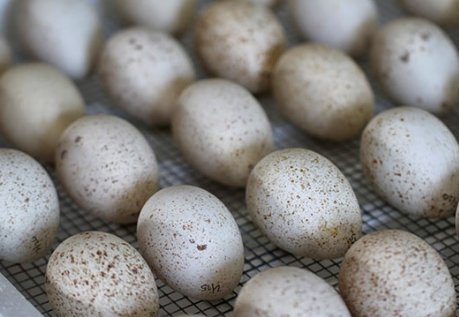
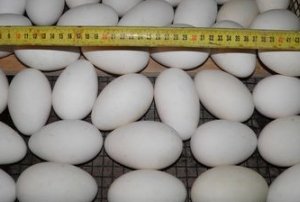
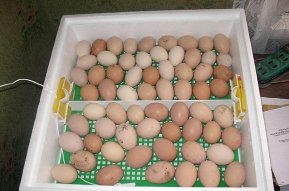
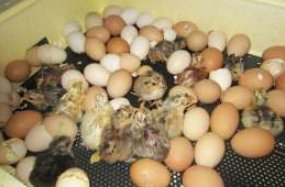
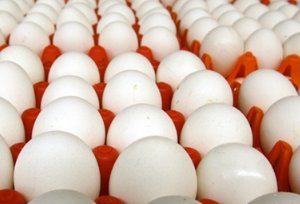

I also raise quails in an incubator. I like doing my own thing. There are no problems. If everything is done on time.